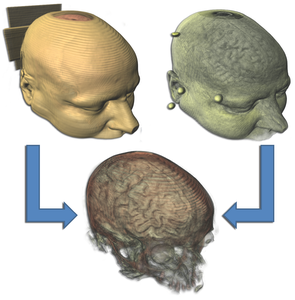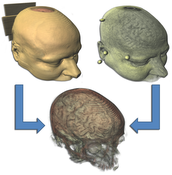Information
- Publication Type: PhD-Thesis
- Workgroup(s)/Project(s):
- Date: 2011
- Date (Start): October 2007
- Date (End): June 2011
- TU Wien Library:
- 1st Reviewer: Eduard Gröller
- 2nd Reviewer: Timo Ropinski
- Rigorosum: 17. June 2011
- First Supervisor: Eduard Gröller
- Keywords: Scientific visualization, Information theory, Volume classification
Abstract
Scientific visualization is a research area which gives insight into volumetric data acquired through measurement or simulation. The visualization allows a faster and more intuitive exploration of the data.Due to the rapid development in hardware for the measurement and simulation of scientific data, the size and complexity of data is constantly increasing. This has the benefit that it is possible to get a more accurate insight into the measured or simulated phenomena. A drawback of the increasing data size and complexity is the problem of generating an expressive representation of the data.
Since only certain parts of the data are necessary to make a decision, it is possible to mask parts of the data along the visualization pipeline to enhance only those parts which are important in the visualization. For the masking various properties are extracted from the data which are used to classify a part as important or not. In general a transfer function is used for this classification process which has to be designed by the user.
In this thesis three novel approaches are presented which use methods from information theory and statistics to enhance features from the data in the classification process that are important for a certain task. With the tools of information theory and statistics it is possible to extract properties from the data which are able to classify different materials or tissues in the data better than comparable other approaches.
One approach adaptively extracts statistical properties, i.e. the mean value and the standard deviation, of the data values in the local neighborhood of each point in the data set. With these statistical properties it is possible to better distinguish between different materials in a data set even though the data is very noisy.
The other two approaches in this thesis employ methods from information theory to extract features from multimodal data sets. Thus it is possible to enhance features of the data which are either very similar or very dissimilar in both modalities. Through information theory the variations in the value ranges of both modalities do not influence the classification of these features.
All three approaches define novel transfer-function spaces which simplify the design process of a transfer function for the user. Different features of the data, such as different materials, can be clearly depicted in these spaces. Therefore, it is easier for a user to design a transfer function which enhances the features of importance for a certain task.
For each of the new approaches results and comparisons to other existing techniques are shown to highlight the usefulness of the proposed methods. Through the described research it is shown that information theory and statistics are tools which are able to extract expressive properties from the data.
In the introduction a broad overview over scientific visualization and the visualization pipeline is given. The classification process is described in more detail. Since information theory and statistics play an important role for all three approaches, a brief introduction to these concepts is given as well.
Additional Files and Images
Weblinks
No further information available.BibTeX
@phdthesis{haidacher-2011-phd,
title = "Information-based Feature Enhancement in Scientific
Visualization",
author = "Martin Haidacher",
year = "2011",
abstract = "Scientific visualization is a research area which gives
insight into volumetric data acquired through measurement or
simulation. The visualization allows a faster and more
intuitive exploration of the data. Due to the rapid
development in hardware for the measurement and simulation
of scientific data, the size and complexity of data is
constantly increasing. This has the benefit that it is
possible to get a more accurate insight into the measured or
simulated phenomena. A drawback of the increasing data size
and complexity is the problem of generating an expressive
representation of the data. Since only certain parts of the
data are necessary to make a decision, it is possible to
mask parts of the data along the visualization pipeline to
enhance only those parts which are important in the
visualization. For the masking various properties are
extracted from the data which are used to classify a part as
important or not. In general a transfer function is used for
this classification process which has to be designed by the
user. In this thesis three novel approaches are presented
which use methods from information theory and statistics to
enhance features from the data in the classification process
that are important for a certain task. With the tools of
information theory and statistics it is possible to extract
properties from the data which are able to classify
different materials or tissues in the data better than
comparable other approaches. One approach adaptively
extracts statistical properties, i.e. the mean value and the
standard deviation, of the data values in the local
neighborhood of each point in the data set. With these
statistical properties it is possible to better distinguish
between different materials in a data set even though the
data is very noisy. The other two approaches in this thesis
employ methods from information theory to extract features
from multimodal data sets. Thus it is possible to enhance
features of the data which are either very similar or very
dissimilar in both modalities. Through information theory
the variations in the value ranges of both modalities do not
influence the classification of these features. All three
approaches define novel transfer-function spaces which
simplify the design process of a transfer function for the
user. Different features of the data, such as different
materials, can be clearly depicted in these spaces.
Therefore, it is easier for a user to design a transfer
function which enhances the features of importance for a
certain task. For each of the new approaches results and
comparisons to other existing techniques are shown to
highlight the usefulness of the proposed methods. Through
the described research it is shown that information theory
and statistics are tools which are able to extract
expressive properties from the data. In the introduction a
broad overview over scientific visualization and the
visualization pipeline is given. The classification process
is described in more detail. Since information theory and
statistics play an important role for all three approaches,
a brief introduction to these concepts is given as well.",
address = "Favoritenstrasse 9-11/E193-02, A-1040 Vienna, Austria",
school = "Institute of Computer Graphics and Algorithms, Vienna
University of Technology ",
keywords = "Scientific visualization, Information theory, Volume
classification",
URL = "https://www.cg.tuwien.ac.at/research/publications/2011/haidacher-2011-phd/",
}


 PhD Thesis
PhD Thesis
